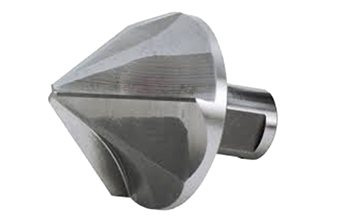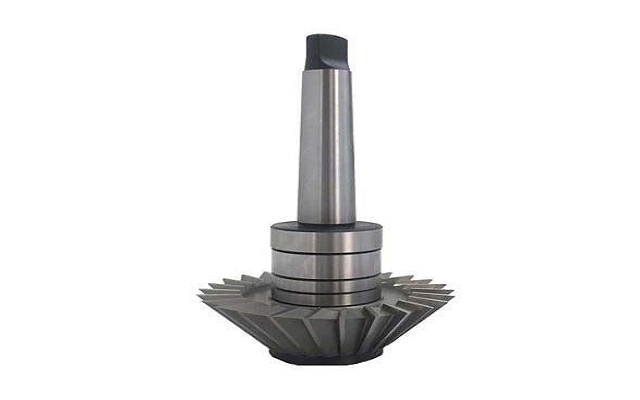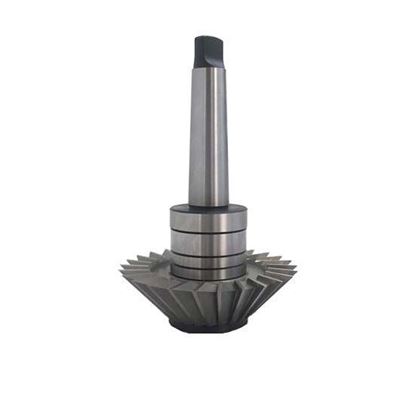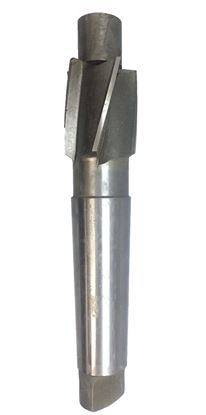Countersinks / Chamfer Tools & Counterbores
Countersinks and chamfer tools are cutting tools used in metalworking, woodworking, and other machining processes to create beveled edges, chamfers, or conical recesses on the surface of a workpiece. These tools serve various purposes, such as enhancing the appearance of edges, improving fitment, or facilitating screw or fastener insertion. Here's an overview of countersinks and chamfer tools:
Countersinks

A countersink is a tool used to create a conical recess at the top of a hole, allowing the head of a screw or fastener to sit flush with or below the surface of the workpiece. Countersinks typically have a conical cutting end with multiple cutting edges. They come in various angles, commonly 60° and 90°, to match the type of screws or fasteners being used. Countersinks are used in applications where a smooth, finished appearance is desired, and where the protrusion of screw heads could interfere with other components. They are commonly used in woodworking, metalworking, and construction projects.
Chamfer Tools
A chamfer tool, also known as a chamfer mill or chamfer cutter, is used to create a beveled edge or chamfer along the edge of a workpiece or a hole. Chamfers are often applied to remove sharp edges, prevent chipping, or allow for easier insertion of parts. Chamfer tools come in various shapes and angles, such as 45°, 60°, and 90°, to produce different chamfer profiles. They are used in a wide range of industries, including automotive, aerospace, electronics, and woodworking.
Key Features And Uses Of Countersinks And Chamfer Tools:
Material Compatibility:
Countersinks and chamfer tools are available in different materials, including high-speed steel (HSS), carbide, and cobalt, to accommodate various workpiece materials, from softwoods and plastics to metals like steel, aluminum, and stainless steel.
Types of Countersinks:
There are different types of countersinks, including single-flute, multi-flute, and adjustable countersinks. Single-flute countersinks are suitable for softer materials, while multi-flute countersinks offer improved chip evacuation and better surface finish in harder materials.
Hand Tools and Power Tools:
Countersinks and chamfer tools can be used with hand tools, such as hand drills and countersink sets, or with power tools like drill presses and milling machines for more precision and efficiency.
Depth Control:
Some countersinks and chamfer tools come with adjustable depth stops or depth settings to control the depth of the chamfer or countersink.
Specialized Applications:
In addition to general-purpose countersinks and chamfer tools, there are specialized versions for specific applications, such as deburring or chamfering the inside of holes.
High-Speed Machining:
In modern machining, chamfer tools can be used in high-speed machining (HSM) processes to quickly and accurately create chamfers and deburring operations.
Complex Machining:
In CNC machining, countersinks and chamfer tools are often integrated into tool changers and used alongside other cutting tools for more complex machining operations.
Both countersinks and chamfer tools play a significant role in achieving smooth, finished edges and precise hole profiles in various manufacturing and construction applications. Their versatility and ability to improve the functionality and appearance of components make them essential tools in the toolbox of machinists, woodworkers, and craftsmen.
Counterbores

A counterbore is a specialized cutting tool used in machining and manufacturing processes to create a cylindrical recess at the top of a hole. This recess allows for the insertion of bolts, screws, or other fasteners while ensuring that their heads are flush with or below the surface of the workpiece. Counterbores are commonly used to provide a clean, finished appearance and to prevent interference with other components.
Key characteristics and uses of counterbores:
Tool Design: A counterbore consists of a cylindrical shank and a cutting head. The cutting head has a flat bottom and may include multiple cutting edges or flutes. The diameter of the counterbore corresponds to the size of the fastener being used.
Function:
The primary purpose of a counterbore is to create a recess for the head of a screw or bolt, allowing it to sit flush with the workpiece surface. This prevents the fastener head from protruding and interfering with other components.
Different from Countersink:
While counterbores and countersinks are similar in concept, they serve slightly different purposes. A countersink creates a conical recess for the screw head, while a counterbore creates a cylindrical recess for the bolt head.
Depth Control:
Some counterbores have depth control features, such as adjustable depth stops, to ensure consistent depth across multiple workpieces.
Material Compatibility:
Counterbores are available in various materials, including high-speed steel (HSS) and carbide, to accommodate different workpiece materials, from wood and plastics to metals.
Hand Tools and Power Tools:
Counterbores can be used with hand tools, such as handheld drills, or with power tools like drill presses and milling machines for more precise and efficient machining.
Applications:
Counterbores are used in a wide range of applications and industries, including woodworking, metalworking, aerospace, automotive manufacturing, and construction.
Chamfering and Deburring:
In addition to creating recesses for fastener heads, counterbores can also be used for chamfering or deburring purposes.
Assembly and Aesthetics:
Counterbores are commonly used in applications where aesthetics and precision are important, such as furniture manufacturing, cabinetry, and high-end metal fabrication.
Counterbores are essential tools in machining and fabrication processes where accurate and clean hole profiles are required for proper assembly and functionality. They contribute to the overall quality and appearance of the finished product by ensuring that fasteners are securely attached without interfering with the surface of the workpiece.






